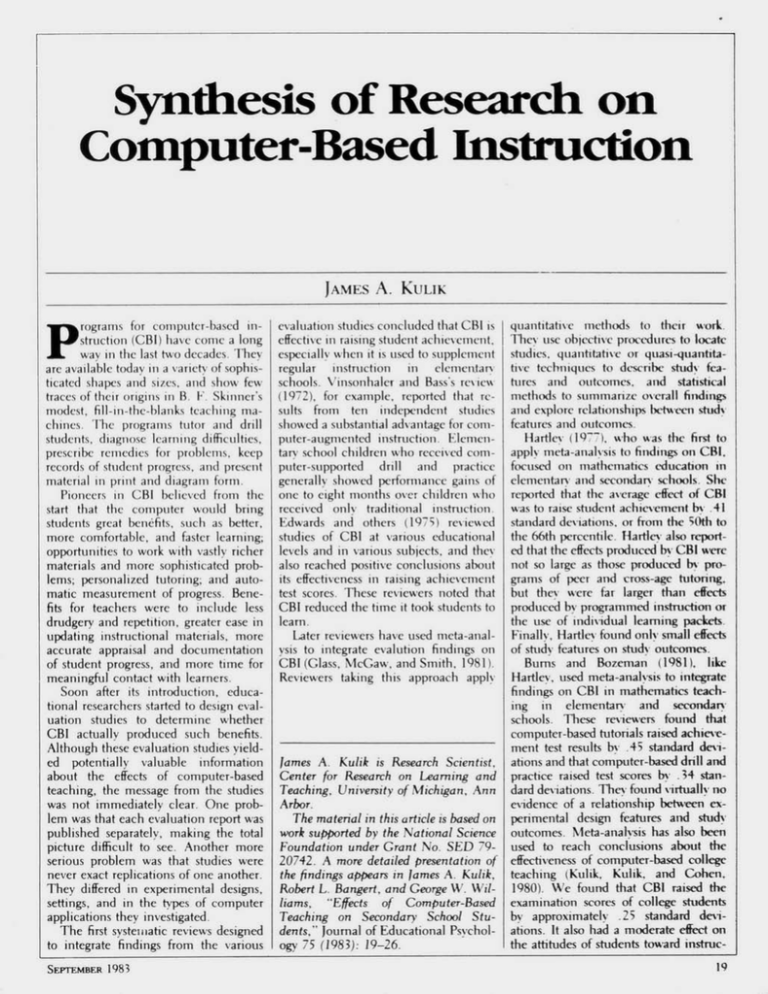
Synthesis of Research on
Computer-Based Instruction
JAMES
rograms for computcr-based instruction (CBI) have come a long
way in the last two decades. They
are available today in a variety of sophisticated shapes and sizes, and show few
traces of their origins in B. F. Skinner's
modest, fill-in-the-blanks teaching machines. The programs tutor and drill
students, diagnose learning difficulties,
prescribe remedies for problems, keep
records of student progress, and present
material in print and diagram form.
P
Pioneers in CBI believed from the
start that the computer would bring
students great benefits, such as better,
more comfortable, and faster learning;
opportunities to work with vastly richer
materials and more sophisticated problems; personalized tutoring; and automatic measurement of progress. Benefits for teachers were to include less
drudgery and repetition, greater ease in
updating instructional materials, more
accurate appraisal and documentation
of student progress, and more time for
meaningful contact with learners.
Soon after its introduction, educational researchers started to design evaluation studies to determine whether
CBI actually produced such benefits.
Although these evaluation studies yielded potentially valuable information
about the effects of computer-based
teaching, the message from the studies
was not immediately clear. One problem was that each evaluation report was
published separately, making the total
picture difficult to see. Another more
serious problem was that studies were
never exact replications of one another.
They differed in experimental designs,
settings, and in the types of computer
applications they investigated.
The first systematic reviews designed
to integrate findings from the various
SS7rEMDER 1983
SEvrMsBER
A.
KULIK
evaluation studies concluded that CBI is
effective in raising student achievement.
especially when it is used to supplement
regular instruction in elemenrtarschools. Vinsonhaler and Bass's res-ies
(1972), for example, reported that results from ten independent studies
showed a substantial advantage for computer-augmented instruction. Elementarv school children who received computer-supported drill and practice
generally showed performance gains of
one to eight months over children who
received only traditional instruction.
Edwards and others (1975) reviewed
studies of CBI at various educational
levels and in various subjects, and thev
also reached positive conclusions about
its effectiveness in raising achievement
test scores. These reviewers noted that
CBI reduced the time it took students to
learn.
Later reviewers have used meta-analysis to integrate evalution findings on
CBI (Glass, McGaw, and Smith, 1981).
Reviewers taking this approach apply
lames A. Kulik is Research Scientist,
Center for Research on Learning and
Teaching, University of Michigan, Ann
Arbor.
The materialin this article is based on
work supported by the National Science
Foundation under Grant No. SED 7920742. A more detailed presentation of
the findings appears in lames A. Kulik,
Robert L. Bangert, and George W. Williams, "Effects of Computer-Based
Teaching on Secondary School Students," Journal of Educational Psychology 75 (1983): 19-26.
quantitative methods to their work.
Thev use objective procedures to locate
studies, quantitative or quasi-quantitative techniques to describe study features and outcomes, and statistical
methods to summanrize overall findings
and explore relationships between study
features and outcomes_
Hartlev (197.), who was the first to
apply meta-analysis to findings on CBI.
focused on mathematics education in
elementanr and secondarn schools. She
reported that the average efect of CBI
was to raise student achievement by .41
standard deviations. or from the 50th to
the 66th percentile. Hartley also reported that the effects produced by CBI were
not so large as those produced by programs of peer and cross-age tutoring,
but they were far larger than eect
produced by programmed instruction or
the use of individual learning packets.
Finally, Hartley found only small elect
of study features on study outcomes.
Bums and Bozeman (1981). like
Hardley, used meta-analysis to integrate
findings on CBI in mathematics teaching in elementary and secondary
schools. These reviewers found that
computer-based tutorials raised achievement test results by .45 standard deviations and that computer-based drill and
practice raised test scores by .34 standard deviations. The' found virtually no
evidence of a relationship between experimental design features and study
outcomes. Meta-analysis has also been
used to reach conclusions about the
effectiveness of computer-based college
teaching (Kulik, Kulik, and Cohen.
1980). We found that CBI raised the
examination scores of college students
by approximately .25 standard deviations. It also had a moderate effct on
the attitudes of students toward instruc19
19
tion and the subject being studied. Finally, we found that CBI reduced substantially the amount of time needed for
instruction.
The following describes findings from
a meta-analysis on CBI effects that I
recently completed with the help of my
colleagues Robert Bangert and George
Williams. Our analysis focused on applications of CBI in grades 6 through 12
and went beyond earlier efforts in at
least two respects. First, it examined the
most recent applications of CBI as well
as early programs. Second, it examined
a wider variety of instructional outcomes than did earlier meta-analyses.
Method
The data for the meta-analysis came
from 51 objective, comparative studies
of CBI located through computer
searches of the educational literature.
The studies covered five different types
of applications of the computer in
teaching: drill and practice, tutoring,
computer-managed teaching, simulation, and programming the computer to
solve problems. The studies also differed
in experimental design, course setting,
and publication history. Categorical
variables, similar to those used in our
previous meta-analyses (Kulik, Kulik,
and Cohen, 1980), were used in classifying the studies according to their features.
The 51 studies also described educational outcomes in four different areas:
learning, academic attitudes, attitudes
toward the computer, and instructional
time. To quantify effects of grouping in
each of these areas, we used Glass's
index of Effect Sizes ES (Glass,
McCaw, and Smith, 1981). This index
gives the number of standard deviations
that separate the group averages that are
being compared. For the present analysis, the index was defined as the difference between the mean of the class
taught with CBI and the mean of the
conventionally taught control class, divided by the standard deviation of the
control class.
Learning Outcomes
Forty-eight of the 51 studies described
effects of CBI on achievement test
scores. In more than 80 percent of the
studies, students from the CBI class
received at least slightly better scores
than did students from the control class.
In more than 90 percent of the 25
studies reporting a statistically significant difference in results from the two
teaching approaches, students from the
CBI class received the higher scores.
20
The average effect of CBI in the 48
studies was to raise student test scores by
.32 standard deviations, or from the
50th to the 63rd percentile.
Although the effect of CBI was moderate in the typical study, the size of
effect varied from study to study, ranging from highly positive to moderately
negative. It seemed possible that this
variation in study outcome might be
systematic, and we therefore carried out
further analyses to determine whether
different types of studies were producing
different results. These analyses, however, did not disclose any strong relationships between study features and
achievement test results. Only two study
features had effects on achievement
scores that reached borderline levels of
statistical significance. These features
were year of publication and duration of
the study. Effects on achievement scores
tended to be somewhat higher in studies
of CBI published during the last five
years. Effects were also somewhat greater in studies of shorter duration.
Academic Attitudes
Computer-based teaching had only
small effects on the academic attitudes
of students. Ten studies, for example,
reported results on students' attitudes
toward the subject matter being taught.
In eight of these studies, attitudes were
more positive in the classroom using
CBI. The average size of effect, however, was only .12 standard deviations.
Another four studies reported on student
ratings of the quality of instruction in
CBI and conventional classes. In each
of the studies, the students from the CBI
class gave the more favorable ratings,
but none of the differences between
classes was statistically significant. The
average size of effect in the studies was
.19 standard deviations, again a small
effect.
Anne
Adam.on
"The average
effect of CBI in
the 48 studies
was to raise
student test
scores... from
the 50th to the
63rd percentile."
Attitudes Toward Computers
The effect of CBI on attitudes toward
computers was strikingly different from
its effect on academic attitudes. Four
studies reported results in this area. In
each of these studies, student attitudes
toward computers were more positive in
the CBI class, and in three of the
studies, attitudes were significantly
more positive among students who used
CBi. The average size of effect was .61,
a moderate to large effect.
Instructional Time
Only two studies contained comparative
data on the amount of time students
EDUCATIONAL LEADERSHIP
took to learn. In one of the studies,
students spent 220 minutes on instruction and study when taught in a conventional manner and 135 minutes when
taught with computers, for a 39 percent
savings in time. In the other study.
students spent 745 minutes on instruction and study when taught conventionally and 90 minutes when taught with
computers, for an 88 percent savings in
time. These effects are obviously large
enough to be of practical importance.
Discussion and Conclusions
The findings of this meta-analysis are
consistent for the most part with findings of earlier reviews. Other reviews
have also reported moderate-size effects
on achievement test scores from computer-based teaching, and other reviews
have also stressed the potential importance of the computer in saving instructional time. Our findings on attitudinal
effects should seem less familiar. Most
reviews do not examine effects of CBI in
the attitudinal domain. The attitudinal
findings, however, are potentially important. CBI appears to have an important positive effect on student attitudes
toward computers and also appears to
have a smaller positive effect on student
school attitudes.
Like other meta-analysts working in
this area, we found that features of
studies were not strongly related to study
outcomes. None of the relationships
between study features and outcomes
that we investigated, in fact, could be
considered clearly statistically significant with the number of studies available to us. Nonetheless, the few small
correlations of borderline significance
that we found were interesting because
they confirmed findings from earlier
meta-analyses.
The tendency for more recent studies
to produce stronger results, for example.
has been noted several times in the past
in meta-analyses on instructional technology. Hartley (1977) noted this tendencv in studies of programmed instruction at the elementary and secondary
levels, and Kulik (1981) noted the same
effect in two separate meta-analyses of
findings on programmed instruction at
the secondary and college levels. It
seems unlikely that the stronger effects
reported in more recent studies can be
attributed to a switch in recent vears to
better research designs. None of the
meta-analyses showed great improvements in research methodology over
time, and they all reported little relationship between research design features and study outcomes. It seems
more likely that instructional technology has simply been used more appropriately in recent years.
Highlights from Research on
Computer-Based Instruction
Other meta-analvses on instructional
technology have also found an invers
relationship between studs length and
strength of effects. Cohen. Kulik, and
Kulik (1982), for example, reported a
similar result for programs of cross-age
and peer tutonng in elementarn and
secondary schools. Although the smaller effects reported in longer studies man
actually show that experimental e&cts
decrease in potency with extended
use-too much of a good thin---t is
also possible that shorter studies are
better controlled and more likelh to
estimate true effects.
One final point should be kept in
mind by readers forming an overall
impression of computer-based teaching
on the basis of this or other metaanalvses. It concerns the veyn nature of
the method. Meta-analVsis provides a
way of determining the major themes in
research studies that have aleads been
carried out. It thus provides a picture of
the past. It does not necessarily give us a
good view of the future. Developments
in computer technology have been occurring so swiffly that no one can predict with confidence what the next fel
years will bring in computer-based
teaching.O
References
Bums. P. K.. and Bozeman. W. C.
"Computer-Assisted Instruction and Mathematics Achievement Is There a Relationship?" Educational Technolgy 21 (19814
32-39.
Cohen. P. A.; Kulik. Il A.; and Kulik
C. -L. C. "Educational Outcomes of Tutoring: A Meta-Analysis of Findings. Arnican Educational Research Journal 19 (19821
A meta-analysis of 51 studies of computer-based instruction shows
that:
* CBI can improve student learning. The average effect is to raise
student test scores from the 50th to the 63rd percentile.
* Student attitudes toward the subject being learned and student
ratings of the quality of instruction are slightly more favorable with
CBI.
* In contrast, students' attitudes toward computers are strikingly
more positive as a result of CBI.
* Finally, CBI has been reported as saving anywhere from 39 percent
to 88 percent of student learning time.
* Because of the rapid change in computer technology and dclassroom use of computers, these findings do not necessarily predict
future results.
Resource Information Service (RIS) provides ASCD members access to
research and sources of information on selected topics. The information is available through RIS-sponsored research syntheses, the RIS
column in Update, and the quarterly publication of Curriculum Update.
237.
Edwards. J.; Norton. S.: Talor. S..
Weiss, M.; and Dusseldorp. R. "How Elective is CAI? A Review of the Rcarch_ Educational Leadership 33 (1975): 147-153
Glass. G. V.; McGaw. B.; and Smith.
M. L. Meta-Analysis in Social Rmwrch.
Beverly Hills: Sage Publications. 1981.
Hartlek. S. S. "Meta-Analysis of dte ELfets of Individuallyv Paced Instruction in
Mathematics." Doctoral dissertation, University of Colorado. 197 .
Kulik, i. A. "Integrating Findings From
Different Levels of Instruction." Paper pesented at the American Educational Rrsearch Association. Los Angeles. April 1981.
Kulik. J A.; Kulik, C.-L. C.;and Cohen.
P. A "Efectiveness of Computer-Based
College Teaching. A Meta-Analysis o Findings." Review of Educational Re6ewc 50
(1980): 525-544.
Vinsonhaler. J. F., and Bass. R. K. "A
Summary of Ten Maor Studies on CAI
Drill and Practice."
12 (1972): 29-32.
1983
SEPTEMBER 1983
SEPrEMBER
Educationalm
Tachndiogy
21
21
Copyright © 1983 by the Association for Supervision and Curriculum
Development. All rights reserved.



